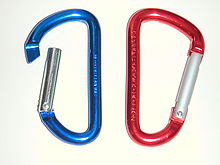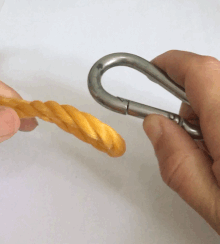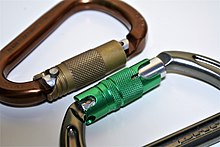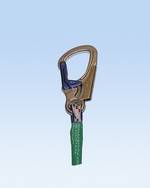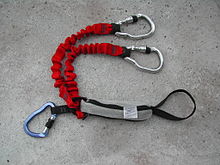Snap hook
A snap hook or short carbine is a hook with spring Schnapperverschluss. Originally it was used by cavalrymen to quickly attach the carbine to the bandolier .
history
A comparable device is mentioned in the work War Art on Horseback by the military writer Johann Jakob von Wallhausen , published in 1616 :
"... Eysen has a loop on it with a little hook, like a feather, so that the pipe, if it hangs in it, cannot fall out."
A first description can be found as early as 1785 in an edition of the Economic Encyclopedia :
“The snap hook is an elongated curved ring, which is wider at one end than at the other, and has an opening on one long side, to which an elastic spring is attached, which yields when the moving part is pressed , but also immediately, when the karabiner ring is inserted, that part of the hook which is movable and has a point at the front end which fits into the other half of the ring, knocks back and closes. "
The travelogue Latest Journey through England, Scotland, and Ireland, ... , p. 336 from 1799 reports on a flourishing carabiner production :
“… Wolverhampton supplied the finest steelwork, in buckles, buttons, rings, watch chains, etc. All factories of this kind would have almost disappeared now, had it not been for the important item of rapier hilts and snap hooks that were left and more than ever had been demanded. ... Single and double swivels have been in great demand since the volunteers were set up. "
In 1830 Giuseppe Bonaiti began to manufacture carabiner hooks for shipping at Lecco in Italy on Lake Como .
The Giuseppe & F.lli Bonaiti SpA in 1938 in Calow province of Bergamo founded by the great-grandson Giuseppe Bonaitis. In 1977 KONG SpA took over the production with the manufacture of carabiners.
On April 7th, 1868, a simple snap hook for connecting chain links was patented in the USA.
The first snap hooks were introduced in mountain sports around 1900.
The snap hook was first used in climbing by Otto Herzog in 1910 after he had observed a fire brigade exercise in Pasing near Munich and tested the snap hook in the Buchenhain climbing garden near Munich.
Applications
Carabiners are used for quick attachment to eyelets and loops. Simple carabiners with low breaking loads are sufficient for light objects. Safety-critical applications require compliance with standards.
For fall protection use only climber carabiner that meet the standard EN 12275th This defines minimum breaking load values and test methods for mountaineering equipment. According to this, the base and HMS carabiners must hold closed in the longitudinal direction at least 20 kN, with transverse load 7 kN, and with an open gate 6–7 kN depending on the type. Carabiners approved for via ferrata have breaking load values of at least 25 kN, as they are exposed to greater loads in the event of a fall . Nominal breaking load values must be indelibly marked on the carabiner for the closed and open state as well as for transverse load. Furthermore, the type-dependent opening widths and the resistance of the catch are specified.
In addition, the UIAA also defines a standard that applies stricter standards to durability. Although mountaineering carabiners are often UIAA certified, this is not absolutely necessary in order to be allowed to market the carabiner hooks.
The snap hooks used for climbing consist almost exclusively of aluminum for reasons of weight.
Protective equipment approved for industrial use must meet the requirements of EN 362.
Even paragliders and hang gliders put a carbine as a connecting element between the drone and harness. These are locking carabiners, often trilock, with straight edges in order to load an inserted webbing strap as evenly as possible. In contrast to mountain sports with their aluminum carabiners, these are also made of steel.
Divers use swivel carabiners (also known as “bolt snaps” or “snap hooks”) made of stainless steel. In addition to being corrosion-resistant, they are less easy to open unintentionally and guide lines do not get caught in the hook unnoticed.
In everyday life, the carabiner is used to attach smaller objects. There is a scissor snap hook on the dog leash for quick opening. Snap hooks are used to fasten chains on pieces of jewelry.
construction
Basically, a carabiner consists of a hook and a snap that is held closed by a spring. The bow is used to take the load so that the carabiner is loaded in the longitudinal direction. The snapper forms a positive connection with the nose. If the carabiner is loaded in the transverse direction or with an open gate, the breaking load values are greatly reduced.
Catches can be constructed as massive full catches or as wire catches. Wire latches are lighter and don't need an extra spring to keep them closed. The lower weight is particularly advantageous when climbing. However, it is less about the luggage to be carried than about the inertia of the snapper. When the carabiner hits the ground, the gate can be open for a split second. With a less sluggish wire gate this time span and thus the risk of open exposure is reduced. Additionally, snappers come in straight or curved shapes. A curved catch makes it easier to hang objects. The lower carabiner of a quickdraw set often has a curved wire gate. Snapper with a lock are only available as straight full snapper.
In order to create a form fit between the snapper and the bow, the nose is often designed like a hook. However, this shape has the disadvantage that objects can get caught on it when unhooked. In situations that require quick unhinging, other constructions such as the keylock, which has a thickening instead of a hook, are used. With wire snaps you can't do without a hook-shaped nose, but here too there are systems that prevent snagging, such as Black Diamonds HoodWire or Petzls Ange Finesse.
Clasp
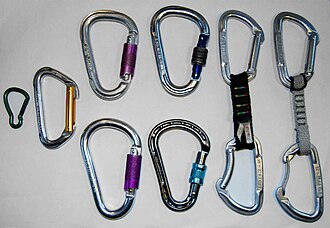
The carabiner is equipped with a lock for safety-critical applications. A sleeve protects the catch against accidental opening. In the open state, the sleeve rests on the catch. To close, it is pushed over the snapper and nose and prevents the snapper from being pushed away from the nose.
Nowadays only self-locking locking carabiners are used in commercial applications.
Screw cap
The locking sleeve of the screw carabiner is guided on a thread , similar to a Maillon Rapide . It is relatively safe against inadvertent movement, since several turns (according to the standard at least 3) of the screw sleeve in one direction are necessary to open it , which is relatively unlikely in the event of accidental contact.
In commercial or rescue applications, however, they are mostly replaced by self-locking carabiners due to human error.
Twist lock
With the twist-lock carabiner, the locking sleeve is so long that it extends over the connection point between the catch and the body even when it is open. However, it has a recess that allows it to be opened (see picture of the paraglider carabiner). This opens on the outside of the carabiner and is brought into the closed position by a spring with a quarter turn around the catch. This mechanism can also be secured by other measures (e.g. Petzl Ball Lock) that fix the lock in the closed and / or open position.
Since the twist-lock mechanism alone can easily get caught in the corners of the recess on items of clothing, other equipment or a rope loop and can open itself in the process, the carabiners have been further developed for self-locking with three independent movements.
Tri-lock
Since the twist-lock carabiner can be opened accidentally through a rope loop or a tape sling , the further developments are so-called "tri-lock" carabiners, which require three independent movements to open them. The long locking sleeve (as with the twist lock carabiner) is first pushed up along the locking axis, then rotated by 90 ° so that it can be opened. This variant is increasingly establishing itself in commercial use.
Safety carabiners
In the mid-1990s, so-called safety carabiners (safety hooks) were developed to prevent accidental opening. A safety bar had to be pressed in order to open the latch. As with the twistlock carabiner, the primary locking mechanism is locked again itself, so two independent movements are required to open.
The technology is used, among other things, on via ferrata carabiners or professional fall protection (construction, fire brigade, rescue services). It has been shown in the course of use and time that these carabiners can accidentally open at edges (especially on narrow passages such as containers or wind turbines ).
Types of carabiners
Normal carabiners
Carabiners without a locking device are usually referred to as normal carabiners . These can be used where the carabiner is not the only security critical (example of this are material carabiners) or where the possibility of being able to open and close the carabiner quickly brings a greater gain in security than the loss of security due to a missing locking device (for example when using with a quickdraw ). As a replacement for a locking carabiner, two normal carabiners can be used in opposite directions (one catch on the left, the other on the right).
Normal carabiners are produced in addition to the variant with a solid gate with a wire gate. With the same breaking load, these have the advantage that the whiplash effect is less pronounced. If a carabiner hits solid structures with its back (the side facing away from the snapper) (e.g. against rock or steel girders in the event of a fall), the snapper opens briefly due to the inertia of the mass . If the carabiner is loaded at the exact moment when it is open, only the back of the carabiner can absorb the force. In general, the breaking load values when the gate is open are less than half of the value when the gate is closed (with most carabiners 9-10 kN open compared to more than 22 kN closed), which can lead to breakage or deformation of the carabiner with a corresponding fall height . The mass of the wire snap, on the other hand, is significantly less than that of a full snap with the same strength. This leads to the fact that the gate opens only minimally and the time span is reduced in which a gate-open load can occur.
In climbing, normal carabiners with curved catches are often used on express sets. The round shape makes it easier to hang the rope.
Special carabiners
HMS carabiner
An HMS carabiner is a carabiner that makes it easier to use a half-mast protection device. Today's HMS carabiners are locking carabiners with a pear-like shape.
When securing, rope is issued and retrieved frequently. The wide head shape of the carabiner allows the knot to jump from one side to the other. The narrower end should make it difficult to twist the carabiner.
Fire brigade carbine
These simple screw carabiners were used for security purposes by fire departments for years. Since the fire brigade as a rescue organization is not bound by European standards, such a procedure was possible and legal. In height rescue groups and when securing against falls in a secured procedure, screw-type carabiners or self- locking carabiners are predominantly used today (according to AGBF ). Occasionally, pipe hooks were also referred to as "fire brigade carabiners ". Among other things, as a firehook , they correspond to the pipe hook .
Pipe hook
In the functional principle, tube hooks are stable versions of a safety carabiner . In order to be able to open the large mouth (mouth opening widths between 60 mm and 120 mm depending on the type - more or less in special shapes), the user has to press the safety bar in order to be able to open the catch. In addition, some types offer the possibility of "knocking" the pipe hook around an anchor point. This means that the pipe hook can be placed around a suitable structure without unlocking, in that the catch strikes against the structure. The pipe hook can then only be removed with deliberate and controlled unlocking.
Via ferrata carabiners
When climbing via ferrata with the help of via ferrata sets , via ferrata carabiners are used. Compared to other karabiners used in climbing, these have a greater breaking strength and have larger dimensions, especially when opening. Via ferrata carabiners have a locking device, whereby different locking mechanisms are used here. Since the carabiners are often hung around on via ferrata, via ferrata carabiners have particularly easy-to-open locking mechanisms. These can include twist locks and palm locks.
Carbine knife
Carabiner knives are carabiners that also contain a small pocket knife. In emergency situations, for example, a rope can be cut, the devices are suitable as a makeshift weapon. Pay attention to the label when using it; the carbine knife may not be suitable for securing when climbing due to its low load capacity.
Jewelry carabiner
The carabiner is also a frequently used element in the jewelry scene. It is a small and mostly filigree type of carabiner and is usually used as a clasp on a chain or bracelet. There are jewelry carabiners in all sorts of colors and alloys, with gold and silver still being the most popular materials. The shape can also be different. There are models that have a more rounded belly or rather flat models. There are also carabiners with decorations and small gemstones inserted. However, they all have one thing in common: Due to their delicacy and small size, the jewelry carabiners require particularly careful handling and should always be protected from heat and moisture in order to avoid rusting the spring and general corrosion.
Web links
- Carabiner with locking device from Panorama 2014/2 (DAV); PDF 836 kB
- Carabiner accident ( Memento from May 29, 2017 in the Internet Archive ) A worn carabiner cuts the climbing rope!
Individual evidence
- ^ Johann Jacob von Wallhausen: Art of war on horseback. Frankfurt / M. 1616, p. 35
- ↑ D. Johann Krünitz: Economic Encyclopedia or General System of Land, House and State Economy in Alphabetical Order, Volume 34 , Joachim Pauli, Berlin 1785, p. 628 ff
- Jump up ↑ Recent tour of England, Scotland, and Ireland, mostly related to products, factories, and action. Tuebingen 1807
- ↑ Giuseppe & F.lli BONAITI SpA Storia (Italian)
- ^ "History" of the Kong company in Italy
- ↑ Patent of an early carbine from 1868
- ↑ Yearbook for mining and metallurgy in Saxony 1908, p. 98 ff.
- ↑ Mailänder, Nicholas, 1949-: Under the sign of Edelweiss: the history of Munich as a mountaineering city . AS Verlag, Zurich 2006, ISBN 978-3-909111-28-2 , p. 109 .
- ^ Pit Schubert: snapper, screwdriver and companion . In: mountaineering . No. 1 , 2004, p. 62–67 ( PDF ; 2.5 MB [accessed December 3, 2015]).
- ↑ DIN EN 12275: 2013 Mountaineering equipment - Carabiners - Safety requirements and test methods . Beuth Verlag , Berlin 2013 (26 pages).
- ↑ Tobias Sessler: Via ferrata set. The via ferrata set - via ferrata equipment. klettersteige-online.de, accessed on January 11, 2012 .

